Hey, did you hear that someone flew a drone in Yellowstone and it crashed and sank in the Grand Prismatic Spring? It is, of course, illegal to fly drones in the National Parks but some dumb cluck did and it crashed into one of the most marvelously colored springs in the park. The park service can’t see the drone from the boardwalk around the spring, of course, since the spring is 300’ in diameter and 160’ deep and very opaque so they might have to fly a helicopter over it to find the drone. What kind of numbskull would do something like this?
I’ll have to admit that we saw people do some dumb things in the park: like walking within 20’ of a bison - with their kids, like stopping their car in the middle of the road to get out and snap a picture of a bison, like letting a 4-yr old get out of the car - alone - in the middle of traffic to see a bison, like stepping off the walkways to see the colors better. Why, oh why, do people leave their heads at home when they leave? You’d think that, since their head is attached to their bodies, that the. head would come along when the body leaves, but, no, somehow, they’ve managed to detach the head and walk out of their homes without any common sense, any thinking ability or any brains. Lots of headless people walking around - but, then, it’s not just at National Parks.
It is possible that the materials in a drone, plastics, batteries, metals, could harm the colors in the spring - forever. Drone expert Patrick Mullen says: “It’s probably a good idea to try to get it out of there, rather than just letting it sit,” said Mullen, who engineers unmanned aircraft. ‘An aircraft like that, god knows what it would do to the chemistry of the pool.’ The pool’s bacteria is what gives it brilliant colors.
This is not the first time that trash has ‘found its way’ in to the pools and geysers of Yellowstone. Back in the 20’s, it used to be quite a trick to toss a dirty handkerchief in to a pool and watch it bubble up clean. ‘Handkerchief Pool’ has never been the same since. Old Faithful used to be used this way also. Old Faithful, the Laundromat.
OK, that’s enough ranting for now. How about another topic? Have you ever heard of Pompey’s Pillar NM? If not, you’re probably not the only one. It’s not the most famous NM, it’s not the biggest, in fact, it might be one of the smallest, but it is pretty interesting. It’s the only tangible, physical evidence that William Clark of Lewis and Clark actually passed this way, actually did travel up the Missouri, through the Louisiana Purchase territory. It’s his signature on a huge pillar of sandstone, in the middle of Montana, on the Yellowstone River. Today we’d call it graffiti but this is actual historical record.
We really hadn’t planned to see it: we’re pretty tired since we’ve been on the go since we left California in early April. We’ve traveled up the coast of Oregon and Washington and then west to Montana. In the last 2 months, we’ve been in 4 National Parks which are just crammed jammed full of neat things to see. We’ve been getting back to the RV about 7:30 in the evening. BUT, this is a National Monument and we’re in the area, let’s go see it. 80 degrees at 8:30 when we take off - looks like it will get up to 97 as predicted.
So, we’re on our way about 8:30, down Interstate 90 to Fly Creek Road, a gravel road but in pretty good shape. We’re tooling right along - until we hit the grader and slow down to a modest 5 mph. Doesn’t look like the grader even notices us so we drop back the required 50’ and chug along after it. Finally it lets us pass, we speed up, find the NM entrance and park in the parking lot. Hmm, why is that tire light on? Better check and - sure enough - here’s what we see. Oops.
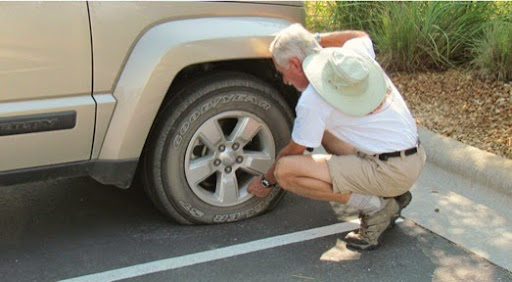
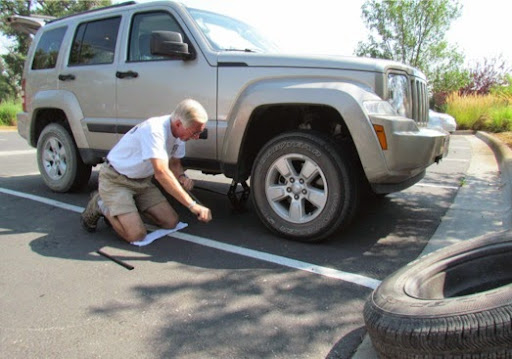
We toured the museum and took the Ranger walk at 1:00 up to Clark’s signature and then to the top of the Pillar.

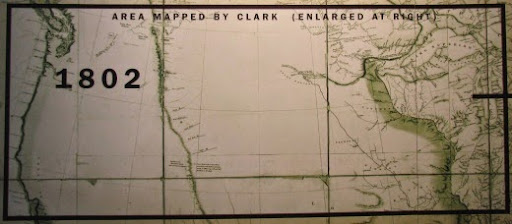
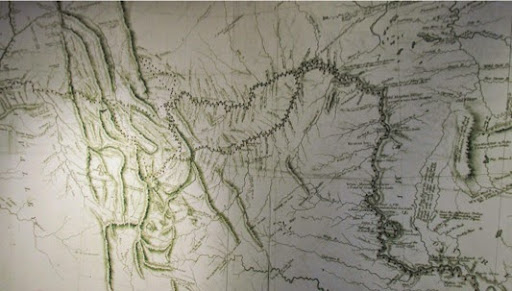
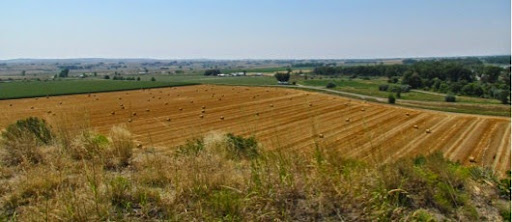
‘this rock, I ascended and from its top had a most extensive view in every direction. . . . The nativs have ingraved on the face of this rock the figures of animals &c. near which I marked my name and the day of the month & year.’ after Satisfying my Self Sufficiently in this delightful prospect of the extensive Country around, and the emence herds of buffalow, Elk, and wolves in which it abounded, I descended and proceeded on.’
William Clark
Pretty cool. Here it is. As you can see around Clark’s signature, there are lots of additions to his signature. Which is graffiti and which is historical record?
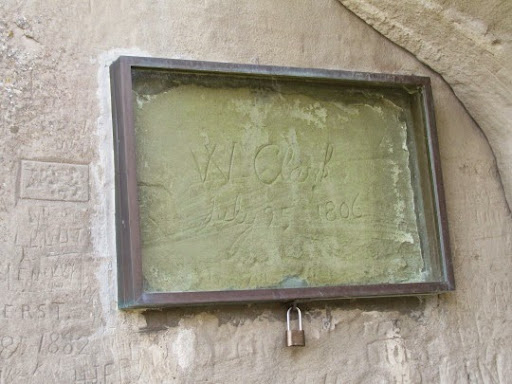
When the railroad went through here, they put an iron grating over this to protect it. Later the the former owners of the property, the Footes, replaced the grate and put this glass case over it. The park service has kept the glass case in place.
Clark named the rock after the son of Charbonneau and Sacagawea, Jean Baptiste. The boy had been born 17 months earlier at Fort Mandan where Lewis and Clark and their company had wintered. Clark had given the boy the nickname of ‘Pomp’ which means ‘little chief’ or maybe it means ‘little dancing boy’ in Shoshoni, Sacagawea’s tribe. No one seems sure which of these meanings is correct. When Clark’s journals were later edited by Biddle and Allen in 1814 for publication, they changed the name of the rock to Pompey’s Pillar - by which name it is known today.
The story of Pomp, Jean Baptiste, is interesting in itself. He was obviously born to be an explorer. When the Corps of Discovery landed in St. Louis, Charbonneau was paid $533.33 and given a land warrant for 320 acres to farm. Guess what Sacagawea was paid? Yep, nothing: although she was only a tag along to her husband, Charbonneau who was hired as an interpreter, she proved to be one of the most valuable members of the expedition. And, she got nothing? But, the land warrants and the $533.33 were a small fortune to Charbonneau but he was not a farmer and sold the land to Clark for $100. Later, after Pomp was weaned, they traveled back to St. Louis to give the child to Clark to raise and educate.
‘As to your little Son (my boy Pomp) you well know my fondness for him and my anxiety to take and raise him as my own child. I once more tell you if you will bring your son Baptiest to me I will educate him and treat him as my own child--I do not forget the promis which I made to you and Shall now repeet them that you may be certain--Charbono, if you wish to live with the white people, and will come to me, I will give you a piece of land and furnish you with horses, cows, & hogs...Wishing you and your family great suckcess & with anxious expectations of seeing my little dancing boy Baptiest I shall remain your friend.’
William Clark
| When he had finished his education, at the age of 18, he headed back to the frontier where he met Prince Paul Wilhelm of Germany who took him back to Germany with him. Here he lived in the court, learned 4 languages and became quite sophisticated. Later he returned to the frontier of America, became in turn a mountain man, a guide, a trapper and a gold seeker. He died of pneumonia and is buried in Danner, Oregon. Interesting that he could be at home and successful in both worlds. But, then, Sacagawea, his mother, was quite amazing also. |

No comments:
Post a Comment